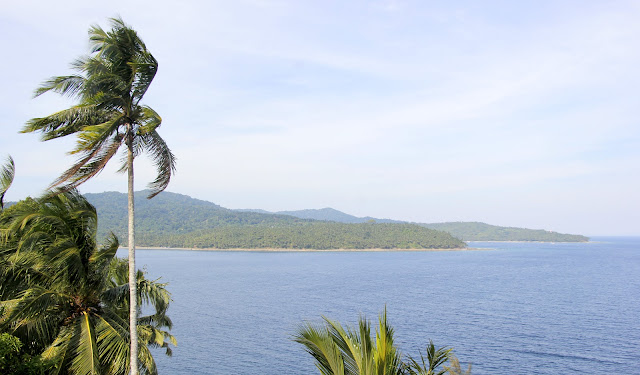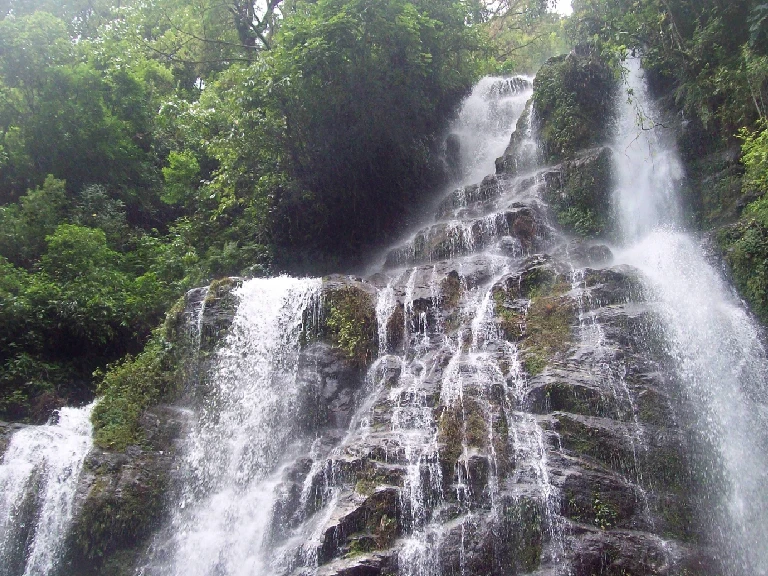Andamans: Lessons in History
I was allowing myself to relax and melt into the sunset colours at Corbyn’s Cove when a familiar voice called me, ‘Ki Dada, how was your visit to the Cellular Jail?’
It
was Mr. Saha who was now becoming a familiar face – I had first met him at the
Calcutta Airport when we were both waiting for our flight to Port Blair, then
at the long queue outside Cellular Jail and now, again here at Corbyn’s Cove. I
realised in my travels around these islands that, most tourism packages here
are cookie-cut – sunrise at a particular east-facing location, midday somewhere
else and sunset at a west-facing vantage point. Defying this is touristy
anathema and severely discouraged by guides and taxi-drivers implying you are
very likely to meet your travelling compatriots on these sunrise and sunset
points on multiple occasions.
We
exchanged few notes about the prison, and how much history was held within it
when I happened to make a chance remark on the presence of two foreign powers
on this tiny archipelago, that of the British and the Japanese. Mr. Saha, who
was happily indulging in a smoke, showed a faint sign of excitement when he
corrected me with a smile, ‘Not two, but four, and perhaps nearly four and a
half!’
It
took me by surprise. ‘Four?’ I asked.
He
gave me a quick nod and replied with a question, ‘Do you know what these
islands were called in the 1750s?’
I
shook my head and was a bit surprised by his prompt reply, ‘New Denmark!’
‘The
Danes? They were here?’
He
smiled and nodded again, ‘Have you not heard of the Danish East India Company?’
I
strained my memory, thinking aloud, (and almost responding like Dr. Hajra in Sonar
Kella), ‘British East India, yes, Dutch East India yes, but Danish East
India…No’
A
bit more thinking and trawling in my memory made me remark in excitement, ‘I do
recollect Tranquebar on the Eastern Coast … and then there was Shrirampore on
the Hooghly… Andaman would form a wonderful triangle with the others.’
My
colleague responded, ‘Absolutely, that was the objective, the Danes targeted
the Nicobar Islands because they would be closer to the trading hubs of south
east Asia. They also wanted to use the tropical islands to cultivate pepper,
cloves and other spices but the settlement got impacted intensely by yet
another tropical specialty – Malaria, the young colony never survived and New
Denmark - later called Frederick’s Islands after the Danish King - was
abandoned. The Danes, for that matter, never made it big unlike the Dutch or
the British, though they had been on and off from 1650s all the way to the
1850s. Sometimes, they profited from the war among the British, French and
Dutch, by being a neutral power which could trade goods while the others fought
and left them alone. But overall, so far from their motherland near the Arctic
Circle, the Danes never really prospered.’
‘They
sold Tranquebar to the British, isn’t it?’ I recollected from my visit to the
Danish outpost from years back.
‘Along
with Shrirampore and Frederiksnagore in West Bengal and then the Nicobar
Islands.’ It was then that Mr. Saha reminded that he himself hailed from
Bandel, once a Portuguese colony, not very far from Shrirampore. He explained
it – with a fake sense of humility - as the reason for his active research on
the European colonies in India. Nonetheless, it was interesting learning for me
and I asked him to continue on these islands. All humility disappeared and Mr.
Saha’s mask of pedantry reappeared.
‘By
the mid1800s, the Danes had given up everything to the British. But something
interesting happened in the 1780s – guess which power showed interest here?’
I
had no answer and Mr Saha continued, ‘Here came yet another company, this time
the Austrian East India Company. A Dutch born British merchant by the name of
William Bolts convinced the monarchs of the Habsburg Empire, Queen Theresa and
King Joseph II, to set up shop here, thinking that the Danes had abandoned
their claim. The Austrian ships came trying to establish colonies in Africa,
Malabar and Nicobar, but there was fierce resistance from the incumbents - the Portuguese launched attacks from Goa
while the Danes and Brits opposed here in the Bay of Bengal. The Austrians
didn’t last long – though one of their names has remained; Teressa Island still
today retains the name of the Austrian
Arch-Duchess who had sponsored Bolts expedition.’
I
was amazed to hear the chequered history of these islands when Mr. Saha’s
earlier words struck me ‘ You had mentioned four and a half, so who else were
interested?’
He
smiled yet again, ‘It is hard to guess, but yet another European Power –
Italy.’
I
gave a heavy sigh, wondering who else was missing, but taking my cue, Mr. Saha
smiled, ‘Italy was planning to buy these islands from the Danes in the 1860s
but that didn’t progress well when the main transactors of Rome stepped down to
other roles. Or perhaps who knows, this could have been an Italian colony and
we would have been treating ourselves to Pizza and Sorbet now!’
I
laughed and tried to conclude, ‘So eventually all these got sold to the
British, then Japanese and then British again, then independence.’
‘Nearly,
the Brits tried to hold on a bit longer – after both India and Burma gained
independence, the British wanted to hold onto these islands as their overseas
territories relocating the last of their Anglo folks here, but it didn’t work…’
The
sun was setting fast, we would leave soon but I still had a question, ‘How come
no Indian ruler conquered these islands?’
‘We
never had need to conquer them perhaps. The Europeans needed bases to buy
spices, we never had that need – add the distance factor and the presence of
warring tribes, may be explaining your question. Yet there are records of Chola
Kings using these islands of the naked men (Nicobar) in their conquest of the
south east Asian kingdoms. You will also find mention of Maratha presence here
though I wonder how that was possible.’
As
we walked back to the car-stand, Mr. Saha added the final notes to his
informative thesis on the islands, ’We are walking in the footsteps of many an
explorer here. I have not checked the veracity but apparently Hiuen Tsang, Fahien and even Marco Polo had
all visited these islands implying these were important pit-stops on the Bay of
Bengal many centuries back.’
‘So
much we don’t know,’ I remarked
As
if drawing his epilogue, Mr. Saha continued, ‘And why stop there, go back even
further – there are many lost hidden texts that hint that these islands helped
Lord Ram in his battle of Lanka. And the Vanar sena was actually the
forest men – the Van Naras, or the tribals of these islands.’
‘No
way….’
‘It
does stretch the imagination, but then we really do not know where Lanka is –
Sumatra, Madagascar, Maldives are all possibilities as Valmiki’s Ramayan does
mention that Lanka was 100 Yojanas – 1200 km from the tip where the searching Vanaras
encountered the seas. Of course, covering that distance on the Ram Setu is
unthinkable, but then there are just too many variables in our equation. At the
end of the last Ice Age, when water levels were far lower, we never know how
the lands were connected, today’s Sri Lanka was possibly connected to India,
the Andamans were potentially connected to Burma – which is also how ancient
Africans came to live on these islands. Then, where was the tip of India from
where Hanuman flew and more importantly, where did he fly?’
‘Van-nar…is
it even possible?’
‘No
harm in indulging the imagination, is it? Have you ever wondered where the name
Andaman came from – the Malays used to call these the islands of Handuman –
from Hanuman, and over time, Handuman became Andaman…If so, why not the forest
people or the monkey people in Ram’s war living here?’
I
had a Game of Thrones, Hodor, Hold-the-Door moment as I tried connecting the
hardly visible dots. The sun had set, and I looked at the timeless waves
crashing on the sands guarded by the ancient padauk trees, wondering if any of
these would ever have the answers, in these ancient lands of Handuman….
___________________________
Inspired
by some very interesting conversations with a fellow traveller I had encountered
on multiple occasions in the Andamans
4th May’2024



Comments
Post a Comment